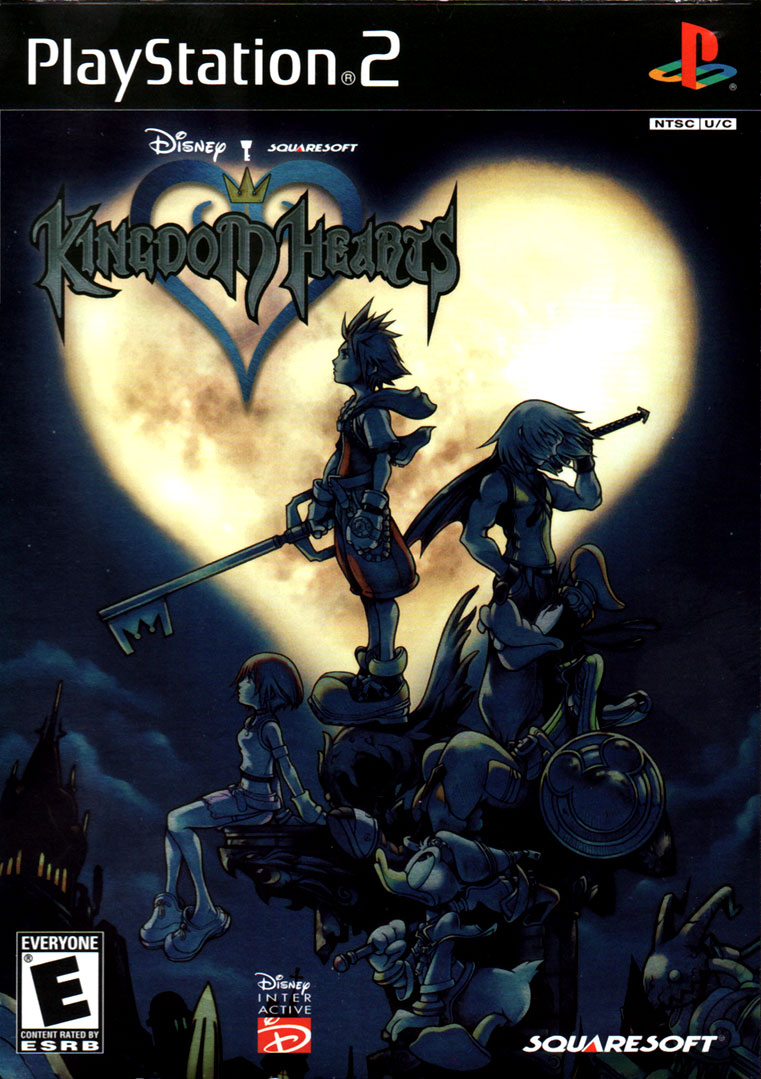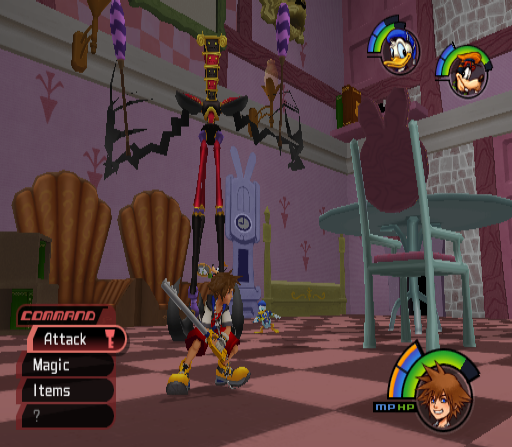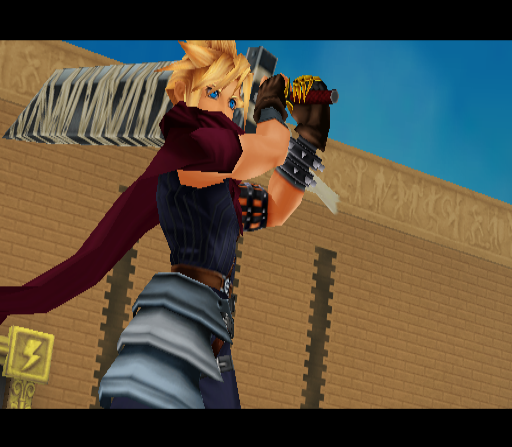Kingdom Hearts
Screenshots for this post come from Moby Games.
 Some sixteen years after it came out, I finally got around to playing all the way through Kingdom Hearts (on PS2). Smudge spent a few weeks going through it at the time, and as usual, I ended up watching much of that, and not finishing it for myself. But I didn’t see everything, and when I got on a computer/console RPG kick earlier this year, playing through our original copy of KH became one of my projects. I was already familiar with the game, so I knew I liked it, but I wanted to see all the way through it, and probably go on to other games in the series.
Some sixteen years after it came out, I finally got around to playing all the way through Kingdom Hearts (on PS2). Smudge spent a few weeks going through it at the time, and as usual, I ended up watching much of that, and not finishing it for myself. But I didn’t see everything, and when I got on a computer/console RPG kick earlier this year, playing through our original copy of KH became one of my projects. I was already familiar with the game, so I knew I liked it, but I wanted to see all the way through it, and probably go on to other games in the series.
Smudge and I were very happy when we first played it for one thing: It’s very much an action game, which we don’t care for, or do well with, but it was simple and fluid enough that we could get into it and do well. That said, there are places that really want you to jump around that tested my patience and dexterity. My biggest problem was the camera controls, which are painful (left and right with no up and down unless you go into a first person mode where you can’t do anything else), and often get blocked by walls or the edges of some fairly constrained environments. However, combat moves well, and is fun, so re-entering an area and fighting the same enemies didn’t annoy me as has happened to me in other games. (Also, there’s a minimum amount of time before enemies reappear, so you don’t deal with them if you’re just hunting around.)
I ended up with an offense-oriented build, and took about 50 hours to finish the game at level 63 without getting through more than half of the optional/side content, and only getting truly stuck about twice. I generally played in fairly short sessions, which presumably added to my time as it no doubt caused more futzing around than if I played straight through.
Concept/Plot

 The base idea of KH is a mash-up fanfic featuring various Disney universes and some Final Fantasy characters. This is the main hook that has gotten a lot of people in the door, but of course, it has its own story, and new characters. The universe is populated by different worlds, which each contain the setting of one of these stories, and are being destroyed one by one. Most of the worlds are Disney properties, but the ones near the beginning and the end are new to the game.
The base idea of KH is a mash-up fanfic featuring various Disney universes and some Final Fantasy characters. This is the main hook that has gotten a lot of people in the door, but of course, it has its own story, and new characters. The universe is populated by different worlds, which each contain the setting of one of these stories, and are being destroyed one by one. Most of the worlds are Disney properties, but the ones near the beginning and the end are new to the game.
The main character, Sora, starts on Destiny Island, and the very beginning of the game is a nicely done and atmospheric tutorial for the basic controls and setting the difficulty. After that… the rest of Destiny Island feels like a slog. There’s activities that are supposed to help with getting used to combat and how to move and jump around, but they skip right over the difficulty level of someone just getting used to the controls (meaning they’re nearly impossible to win for a beginner), and are more difficult than the actual game is at the beginning.
Naturally, Destiny Island is swallowed by the encroaching darkness at the end of the prologue, and Sora is separated from his two closest friends, Riku and Kairi. This forms the main backbone of the story, as he is driven forward to find his friends again. Meanwhile, King Mickey Mouse (of the Magic Kingdom) has become aware of the bigger problem and disappeared on a search for a solution, while Donald Duck and Goofy take off in search of him.
Sora, Donald and Goofy meet in Traverse Town (which becomes the home area of the game) and team up, with Donald and Goofy acting as (very handy) computer-controlled party members. The team visits something like eight other worlds (and some odder locales), fighting their way closer to the… heart of the problem. Against them, the various Disney villains have become aware of what’s up, and have banded together for their own ends…. The end of the game is possibly the main “Final Fantasy” callout, as it’s structured like most FF games: the initial villain isn’t the real villain, and the end of the game feels like a drug trip.
All this makes much of the game episodic, and you can technically go through many sections in the order you like. However, many sections are unlocked by by doing earlier ones, and there’s a steady climb in difficulty (which is clearly marked before you go there). At the end of the game, things naturally narrow down again, though a number of optional tasks are available at the end of the game if you go out and find them. I skipped past much of the later optional content, as it was tougher than I was wanting to deal with by that point, but there’s a fair number of things to do for completists, and the earlier ones are handy for getting better at combat, and some good rewards.
Princesses
The concept of the ‘Disney Princess’ makes it into the game, with a central plot point revolving around seven ‘Princesses of Heart’, which largely corresponds with that line. And it becomes the source of my biggest problem with the game: The damseling of strong female characters.
Thankfully, it’s not universal, notably with Ariel being available as a party member for a portion of the game, and being effective as such. But, she’s the only female character we get to see acting in a proactive way. With several of the other females, this isn’t too bad, especially as many of them are captured off-screen, and some weren’t very active characters to begin with.
However, I felt that Jasmine in particular got very poorly served by the game. The plot of Aladdin is somewhat derailed by the events of Kingdom Hearts, with Jafar making his (overt) moves early, and Jasmine escapes into the city before you (Sora) show up. That’s fine, and what I would expect. But after that, she doesn’t get to do anything, and basically serves as the goal in a multiple boss fights. She’s a very capable character in the movie, but never gets actual on-screen time as such here.
Environments and Music
Being an old PS2 game, the game areas are often more constrained than I expected, and sometimes much more constrained. (The early Alice in Wonderland section has a main room that I had a lot of trouble with simply because it was too small to look around properly.) Graphically, the game does very well for its day, with good use of modeling and textures, and I hope the later high definition reworks have done well for it.
There is a certain amount of jumping around to get from area to area needed in some worlds. Usually, this isn’t too bad, as you get to line up what you’re doing, but Agrabah suddenly forces you into fast jumps. However, the main problem that comes up is some worlds have a very complex set of small areas, that are hard to figure your way around. (I’m amazed someone hasn’t done a flowchart for Deep Jungle on the web, I eventually figured most of it out, but I could have seriously cut down my time in that world if I’d had any idea how to get anywhere.)
The soundtrack is excellent. The various Disney worlds naturally have a theme worked from the appropriate movie’s soundtrack, and I consider some of them weak as they get repetitious with the most recognizable part of the theme (“Under the Sea” was grating for me for being a very repetitious rendering of a very catchy tune). Each world generally has a main theme and a combat theme, and they transition to/from each other very well (I never had a jarring sensation going between them). The non-Disney parts (of which there’s a lot) are excellent, and this is high up on my list of favorite soundtracks.
Conclusion
There’s a reason why Kingdom Hearts became a series that now spans nine games, with the long-delayed Kingdom Hearts III due out next year (there’s been a lot of ‘side’ games in the series). It’s positioned as something of a ‘beginner’ RPG, and aimed at a younger audience. And it’s very well put together, which no doubt has made it an entry point to console RPGs for a lot of people.
One of the big positives about the game is that it is… positive. Sora is an upbeat character who wants to help other people. The general theme of the game is friendship and how just knowing and caring for other people is a positive thing for ourselves. I generally don’t care much for ‘dark and gritty’, and the heroes of Final Fantasy VII and VIII in particular were decided weak points for me in those games. Here, the game is generally upbeat, with visuals and sound to match. Sadly, the writing can dissolve into trite meaningless phrases around the central points on occasion, but it mostly does well, and it’s fun ride all the way through, interrupted by some appropriately challenging fights that are interesting in their own right.

Discussion ¬